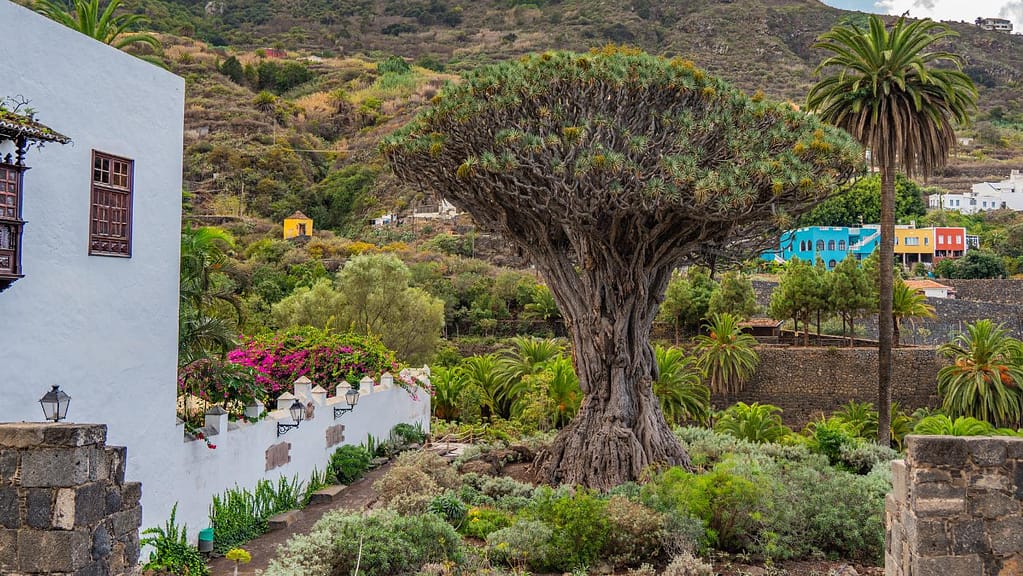Estimated reading time: 9 minutes
Dragon Tree in Tenerife: Facts, Characteristics, and Significance
Uncover its thousand-year-old secrets! Visit the Parque del Drago in Icod de los Vinos to witness the iconic Dragon Tree Tenerife.
As I stand before the magnificent Dragon Tree, I am in awe of its sheer size and age. This tree, also known as the Canary Islands Drago Milenario, is a true wonder of nature and a symbol of the island of Tenerife.
It is said to be over a thousand years old, although its exact age is still disputed by botanists.
Dragon Tree
Located in the Parque del Drago in Icod de los Vinos, Tenerife, the Dragon Tree is the largest and oldest living specimen of the Dracaena Draco species.
Its trunk has a circumference of over 20 meters and its main branches extend over 10 meters in length.
The tree’s red resin, known as dragon’s blood, has been used for medicinal and cosmetic purposes for centuries.
Despite its age and size, the Dragon Tree is evergreen and drought-tolerant, making it a true marvel of nature.
History and Significance of the Dragon Tree, Tenerife North

The Drago Milenario is a legendary tree located in Icod de los Vinos, Canary Islands. As its name suggests (milenario), it is said to be a thousand years old, although the exact age is still disputed.
In this section, I will discuss the history and significance of the Drago Milenario, including its discovery, cultural importance, and conservation efforts.
Discovery
The Dragon Tree was discovered in the 16th century by Spanish explorers who were amazed by its size and beauty. The tree was named after the mythical dragons of yore that were said to become trees when they died.
The bark of the tree produces a red resin that was believed to be the blood of dragons, adding to the tree’s mystical allure.
Cultural Importance
The Dragon Tree has been an important cultural symbol for the people of the Canary Islands for centuries. The tree was worshipped by the ancient Guanche people, who believed it had healing powers and used its resin for medicinal purposes.
Today, the Drago Milenario is a national monument and a popular tourist attraction. Its image can be found on postcards, souvenirs, and even the coat of arms of Icod de los Vinos.
Conservation Efforts
The Drago Milenario is listed as a vulnerable species by the International Union for Conservation of Nature (IUCN). The tree faces numerous threats, including habitat loss, climate change, and disease.
To protect the Dragon Tree, several conservation efforts have been put in place. The tree is surrounded by a protective fence, and visitors are not allowed to touch or climb on it.
In addition, a team of experts regularly monitors the tree’s health and takes measures to prevent its decline.
Description and Characteristics of the Dragon Tree, Tenerife North

Physical Characteristics
I recently visited the Parque del Drago in Tenerife, Spain, where I saw the magnificent Dragon Tree, also known as the Thousand-Year-Old Dragon Tree.
This tree is an impressive natural wonder, standing at a height of 16.4 meters and having a circumference of 17.4 meters. It has approximately 300 main branches and during the flowering season, around 1800 flowers blossom, making the tree at most 3.5 tons heavier.
The Drago Milenario is a monocot, which means it has a single embryonic leaf, and it belongs to the plant genus Dracaena Draco. Its leaves are thick and leathery, and its sap is red, which was once believed to have healing properties.
The tree has a unique umbrella-shaped canopy, which is dense and green, making it a popular spot for tourists and nature enthusiasts.
Habitat
The Dragon Tree is native to the Canary Islands, specifically on the island of Tenerife, where it can be found in the wild. The tree prefers a subtropical climate and can tolerate both drought and salt spray, making it well-suited to its coastal habitat.
In addition to its natural habitat, the Drago Milenario can also be found in botanical gardens and parks throughout the world.
Ecological Importance
The Drago Milenario is an important ecological symbol of the Canary Islands, and it has been protected by law since 1917. The tree has significant cultural and historical importance, and it has been featured in many local legends and myths.
The sap of the tree was once used for medicinal purposes, and the wood was used for making furniture and other household items.
In addition to its cultural and historical significance, the Dragon Tree also plays an important ecological role. The tree provides habitat and food for a variety of wildlife, including birds, insects, and lizards.
Its root system helps to prevent soil erosion, and its leaves and branches provide shade and shelter for other plants and animals.
Uses and Benefits

As I researched the Dragon Tree, I discovered that it has been used in various ways throughout history.
Here are some of the traditional and modern uses of this magnificent tree, as well as its medicinal properties.
Traditional Uses
The sap of the Drago Milenario tree, also known as “dragon’s blood,” has been used for centuries in traditional medicine and as a natural dye. It was also used in ancient times as a varnish for wood and as an ingredient in cosmetics and incense.
In addition, the tree’s leaves and bark were used to make ropes, baskets, and other handicrafts. The Guanches, the original inhabitants of Tenerife, believed that the tree had magical properties and used it in their religious ceremonies.
Modern Uses
Today, the Dragon Tree tree is mainly used for ornamental purposes. It is a popular tourist attraction in Tenerife, and its image is often used to promote the island.
The tree’s resin is still used in some traditional medicines and cosmetics, but its use has declined in recent years.
The tree’s wood is used to make furniture and other decorative items. However, due to the tree’s protected status, the use of its wood is strictly regulated.
Medicinal Properties
The Drago Milenario tree has several medicinal properties that have been studied in recent years. Its sap, or dragon’s blood, has been found to have antiviral, antibacterial, and antifungal properties.
It has also been shown to have anti-inflammatory and antioxidant effects. The tree’s leaves and bark contain compounds that have been found to have analgesic and antitumor properties.
However, more research is needed to confirm these findings and to determine the optimal dosage and method of administration.
Caring for “Dragon Tree” Trees

Planting and Propagation
When planting a Drago Milenario tree, it is important to choose a location with well-drained soil and good air circulation. These trees prefer full sun to partial shade and are evergreen, meaning they keep their leaves year-round.
Propagation can be done through stem cuttings, which should be taken in the spring or summer.
Cut an eight-inch section of stem and place it in a jar of water, making sure the top and bottom ends are noted. Keep the jar in a warm, bright, and indirect light location until roots form.
Watering and Fertilizing
Dragon Tree trees are drought-tolerant and do not require frequent watering. However, they do benefit from occasional deep watering during dry spells.
Fertilizer is not necessary, but a balanced slow-release fertilizer can be applied in the spring and fall to promote growth.
Pruning and Maintenance
Pruning is not necessary for Drago Milenario trees, but dead or damaged branches can be removed as needed. It is important to avoid cutting the main branches, as this can damage the tree and stunt its growth.
Regular maintenance includes removing any debris or dead leaves from around the base of the tree to promote good air circulation.
Similar Species

Dracaena Cinnabari
As I research the Dragon Tree tree, I cannot help but think of its closest living relative, the Dracaena cinnabari, also known as the dragon blood tree.
While the Drago Milenario is a member of the Dracaena family, the dragon blood tree is a separate species altogether. The dragon blood tree is native to the Socotra archipelago, located in the Arabian Sea.
One of the most striking features of the dragon blood tree is its red sap, which has been used for various purposes, including as a dye and a medicine.
The tree itself has a unique shape, with an umbrella-like canopy and twisted, gnarled branches. Like the Dragon Tree, the dragon blood tree is a slow-growing species, taking up to 20 years to reach maturity.
Other Monocots
The Dragon Tree and the dragon blood tree are just two examples of the many species of monocots that exist in the world.
Monocots are a type of flowering plant characterized by having a single cotyledon, or embryonic leaf, in their seeds. They also typically have parallel-veined leaves and flower parts in multiples of three.
Other notable monocots include the banana plant, the orchid, and the palm tree. Each of these species has its unique characteristics and uses, from providing food and fibre to serving as ornamental plants.
It is fascinating to explore the diversity of life that exists within the plant kingdom, and the Drago Milenario is just one example of the many wonders that can be found in nature.
Attractions Tenerife
Plan Your Vacation with these useful links
- Find a flight
Kiwi.com – Helping you to find the cheapest airline tickets.
- Find an accommodation
Welcome to Tenerife. Enter your check-in date and choose from 9628 properties with Booking.com!
- Order taxi transfers from airports and hotels
Kiwi Taxi. Immediate departure, the driver meets you, pay online or in cash.
- Book Your Activities
Top sights you can’t miss in Tenerife! GetYourGuide.
- Rent a Car: Search, Compare, Save
Join now the many satisfied customers of Rentalcars.com – the leading car rental comparison website around the world. Only 3 steps separate you from “four wheels”!
- Ekta – is a new-generation insurance company that combines competitive prices with a high level of service.
You will receive your insurance policy by email within 2-3 minutes. There is a multilingual technical support chat 24/7.

